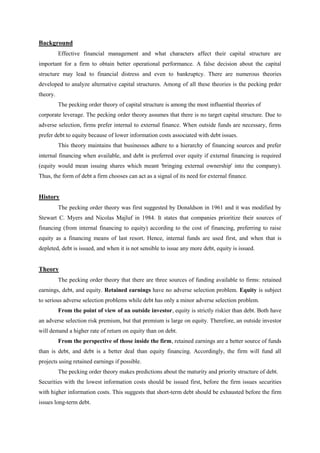
Pecking order theory-Finance
- 1. Background Effective financial management and what characters affect their capital structure are important for a firm to obtain better operational performance. A false decision about the capital structure may lead to financial distress and even to bankruptcy. There are numerous theories developed to analyze alternative capital structures. Among of all these theories is the pecking prder theory. The pecking order theory of capital structure is among the most influential theories of corporate leverage. The pecking order theory assumes that there is no target capital structure. Due to adverse selection, firms prefer internal to external finance. When outside funds are necessary, firms prefer debt to equity because of lower information costs associated with debt issues. This theory maintains that businesses adhere to a hierarchy of financing sources and prefer internal financing when available, and debt is preferred over equity if external financing is required (equity would mean issuing shares which meant 'bringing external ownership' into the company). Thus, the form of debt a firm chooses can act as a signal of its need for external finance. History The pecking order theory was first suggested by Donaldson in 1961 and it was modified by Stewart C. Myers and Nicolas Majluf in 1984. It states that companies prioritize their sources of financing (from internal financing to equity) according to the cost of financing, preferring to raise equity as a financing means of last resort. Hence, internal funds are used first, and when that is depleted, debt is issued, and when it is not sensible to issue any more debt, equity is issued. Theory The pecking order theory that there are three sources of funding available to firms: retained earnings, debt, and equity. Retained earnings have no adverse selection problem. Equity is subject to serious adverse selection problems while debt has only a minor adverse selection problem. From the point of view of an outside investor, equity is strictly riskier than debt. Both have an adverse selection risk premium, but that premium is large on equity. Therefore, an outside investor will demand a higher rate of return on equity than on debt. From the perspective of those inside the firm, retained earnings are a better source of funds than is debt, and debt is a better deal than equity financing. Accordingly, the firm will fund all projects using retained earnings if possible. The pecking order theory makes predictions about the maturity and priority structure of debt. Securities with the lowest information costs should be issued first, before the firm issues securities with higher information costs. This suggests that short-term debt should be exhausted before the firm issues long-term debt.
